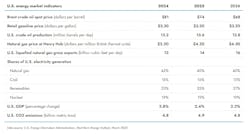EIA updates forecast for natural gas, oil prices
The U.S. Energy Information Administration (EIA) recently revised its forecast for 2025 average U.S. benchmark Henry Hub natural gas spot prices upward following a cold end to February.
EIA also revised its forecast for Brent crude oil spot prices, which the agency now expects it to fall in late 2025, in its March Short-Term Energy Outlook (STEO).
Key highlights from the March STEO include:
- Natural gas consumption and inventories: Cold weather during January and February led to increased natural gas consumption and large natural gas withdrawals from inventories. EIA now expects natural gas inventories to fall below 1.7 trillion cubic feet at the end of March, which is 10% below the previous five-year average and 6% less natural gas in storage for that time of year than EIA had expected last month.
- Natural gas prices: EIA expects higher natural gas consumption and lower natural gas inventories to lead to higher natural gas prices through 2026. EIA expects the Henry Hub spot price to average around $4.20 per million British thermal units (MMBtu) in 2025 (11% higher than last month’s forecast) and near $4.50/MMBtu in 2026 (8% higher than last month’s forecast).
- Crude oil inventories: Global oil markets will remain tight through the middle of 2025 before gradually shifting to oil inventory builds later this year. EIA expects global oil inventories to fall in the second quarter of 2025, in part due to decreasing crude oil production in Iran and Venezuela.
- Crude oil prices: EIA expects the Brent crude oil spot price to rise from its current price near $70 per barrel to about $75 per barrel in the third quarter of this year. However, EIA forecasts oil inventories to build and prices to decrease in late-2025 and through 2026 as OPEC+ unwinds production cuts and non-OPEC oil production grows. EIA forecasts the Brent crude oil price to fall to average $68 per barrel in 2026. EIA points to numerous sources of uncertainty in its price forecast, including the effects of recently announced sanctions against Iran and the revoked oil export licenses for Venezuela.
- Electricity generation: EIA expects the U.S. electric power sector to generate 3% more electricity this year than in 2024, which differs from last month’s forecast growth of 2%. Natural gas and coal both contribute to the increased generation in EIA’s March forecast.
- Electricity consumption: EIA expects a 3% increase in total U.S. electricity sales (a proxy for consumption) in 2025, led by strong growth in the residential and commercial sectors. Residential-sector growth is mostly related to cold weather during January and February that increased electricity consumption for space heating. Commercial-sector growth is being driven by expanding data centers.

